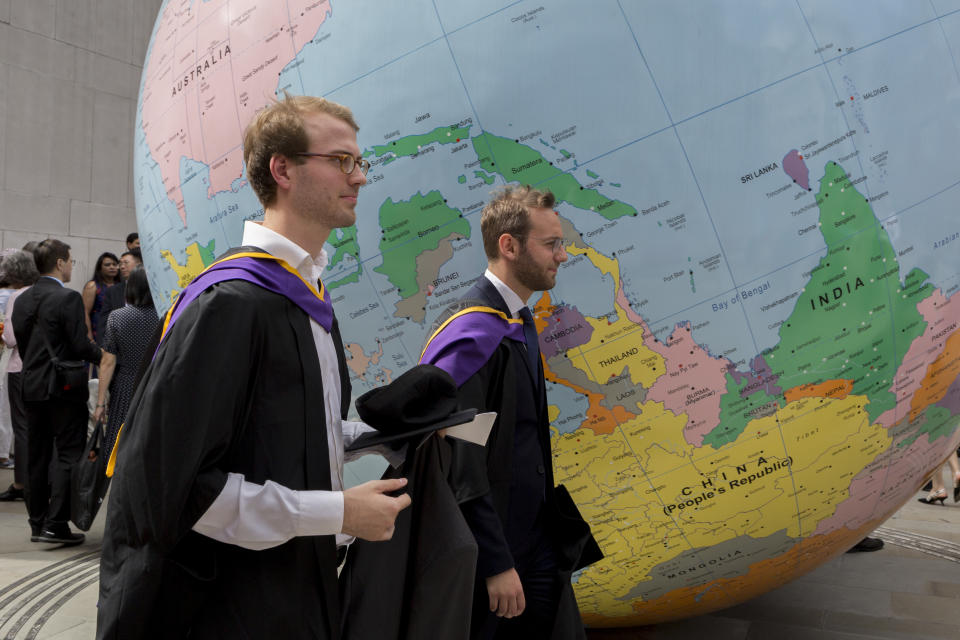How far would you travel for free college?
Free college already exists. You just have to move to Europe.
Germany, Norway, and Iceland offer tuition-free degrees – even to American students – and the education is world-class. Some of the universities are among the top 100 global schools.
Studying permanently abroad in those countries means fewer burdensome college loans after graduation, potentially saving you tens of thousands of dollars. The average cost of tuition and fees in the U.S. is $36,880 per year at private colleges and $10,440 at public universities, according to College Board.
“It’s actually very surprising not just for American students but also for others that you can study at the world's leading universities essentially for free,” said Gerrit Blöss, CEO of Study.eu, a portal for international students in Europe.

You don’t have to speak the local language, either, so there’s no need to sign up for intense foreign- language courses. Speaking English is enough.
“The number of English-taught programs in Europe has been increasing rapidly over the past years,” said Carmen Neghina, a marketing analyst at Studyportals, an information portal for international students in Europe. “What started as a trend for graduate programs is now also expanding at the undergraduate level.”
Here’s a list of high-ranking foreign universities that are tuition-free.
Germany
The largest national economy in Europe is also known for public universities offering tuition-free degrees for international students. And one of these schools ranks among the top 50 worldwide.

What’s more, not all degrees are taught in German. There are over 1,000 programs in English, according to Blöss. Many are for graduate students, but there’s a significant offering for undergrads as well.
You only pay a fee of $100 to $400 to support the student government and student clubs, but, in return, you receive a local transportation ticket for the entire semester.
The application deadline for German universities is around July 15. Keep in mind that there’s stiff competition, Blöss said, and German universities get to pick the best candidates.
Norway
Welcome to Norway, home to glaciers, coastal fjords, Vikings and free tuition at its public universities regardless of your country of origin.

Don’t speak Norwegian? Ikke bekymre deg – or don’t worry. The majority of these universities offer courses in English. Norwegians also are the third-best non-native English speakers in the world, so most people you meet will understand you.
But watch out: Living costs in Norway are higher than other European countries. Rent can range between $1,100 and $2,000 a month, Neghina said.
There’s also a small mandatory tax that students in Norway must pay each semester. Less than $100, it entitles students to sit for exams and finish for the semester. But it also gives discounts for public transportation, museums, cultural events, and access to sports facilities, Neghina said.
Iceland
Another Nordic nation that makes the tuition-free list is Iceland. The island is home to 360,000 people and happens to be a popular school destination for Americans — it’s much closer to the states compared with the rest, Blöss said.

Iceland’s public universities don’t have tuition, but there is an annual registration or administration fee of around $600, which all students pay.
Other affordable options
Along with tuition-free degrees, Europe is also home to many high-ranking universities that cost less than $5,000 a year.
Austria: about $1,700/year
France: about $3,100 to $4,200/year
Greece: about $1,700/year
Hungary: about $1,700/year
Poland: about $2,200/ year
Austria, the fifth-most popular destination for U.S. students, is home to the University of Vienna, which is among the top 150 colleges worldwide.
Until recently, France also had a tuition-free system for international students. But the tuition fees the country implemented remain affordable compared with U.S. options, according to experts. France also offers more scholarships to international students than it did in the past.
Denitsa is a writer for Yahoo Finance. Follow her on Twitter @denitsa_tsekova.
Read more:
Follow Yahoo Finance on Twitter, Facebook, Instagram, Flipboard, SmartNews, LinkedIn, YouTube, and Reddit.

 money
money 
